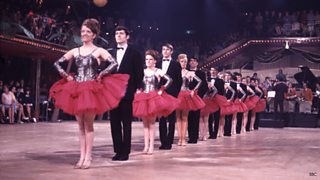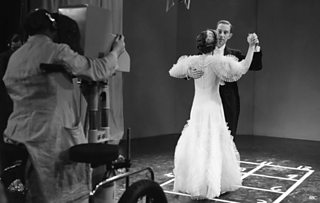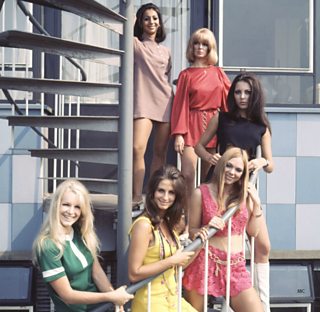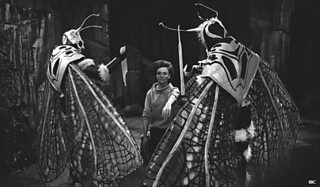
The backbone of the ��������'s dance coverage for nearly 50 years was Come Dancing. Here, a formation team prepare to do battle in Glasgow, 1970 (you can just see the tasteful plastic palm trees)
Dancing is one of the most ancient forms of human artistic expression, with roots in ceremonial behaviour relating to religious rites and courtship behaviours. It can also be fun (especially in the latter case).
It’s not surprising therefore that �������� broadcasts have featured or been related to dance from the earliest days, whether simply music to dance to, or all the other fields that dance can be employed in, up to and including the success of .
There are so many forms of dance, from tap to country, from ballroom to ballet, from jive to street dances, that it would be impossible to give a complete account of the ��������’s coverage in the space available here – so this overview will inevitably be very selective, not that it means we won’t cover other forms individually at a later date.
One of the earliest programmes specifically of dance music, and it seems the earliest billed in Radio Times, was on the Birmingham 5IT service in 1923, where performed, though there is no mention of the music they played, on the listing. The very next day the broadcast from the Savoy Hotel, and this was relayed to a number of other stations.
The �������� would continue to have a long relationship with the Savoy, with acts such as their in-house providing dance music for years to come. The day after the New Savoy Band, the then performed, and again the tradition of the ��������’s own specialist orchestras would go on through the years.
As well as dance music, another feature that radio provided was the dance lesson, such as that given by of the Piccadilly Picture Theatre, Manchester, in 1925. Of course, such things are harder to achieve effectively without any visual component, relying on the descriptive powers of the speaker alone. Soon after the start of television proper in November 1936, professional dancers gave the first of a series of dance lessons that would continue into the late 40s.

Alex Moore and Pat Kilpatrick show how it's done in a 1936 broadcast - with helpful floor markings for the beginner
in August 1939 was an outside broadcast from the eponymous venue in Hammersmith that showed the public dancing to the latest hits played by Oscar Rabin and his Band. It was an early example of popular dance, rather than by professionals, at a time when formal styles of dance predominated in ballrooms.
Post-war, bandleader started to make television programmes too, and he was well known as the exponent of dancing lessons, including in his radio series . His series ran from 1948 to 1962 and always included a dance lesson amongst its features.
came to outshine and outlive Television Dancing Club, and was for many years just about the only place to see ballroom dancing. There is some debate about when Come Dancing began, as it is often quoted as beginning in 1949. However, as can be seen from Genome, the first programme under this title was in 1950, and there doesn’t seem to be a programme that fits its description in 1949.
Devised by Eric Morley, Come Dancing was an occasional programme at first, with two editions in 1950 and two in 1951; from it gradually started to become more frequent though episodes were still well spaced apart. The series was always staged in actual ballrooms and �������� outside broadcast units went to all parts of the country to cover dance competitions, at a time when television coverage was spreading throughout the UK.
It wasn’t until however that Come Dancing became first a monthly, then a fortnightly fixture, and the �������� organised its own inter-regional dancing contest in collaboration with Mecca Dancing. Occasionally it featured the presentation of the prestigious , though these were sometimes also incorporated in other programmes or in a dedicated show.
Come Dancing was primarily an amateur competition, though there were always professionals on hand to give demonstration dances. The competitors came from all walks of life and dancing was their hobby, albeit one that was prone to obsessive levels of time for dancing practice, as well as the time spent on more and more elaborate costumes, especially for the ladies.

Pan's People contravene health and safety regulation 57 (b) subsection 28 by blocking a fire exit at Television Centre
Ballroom dancing of course is just one aspect of dance featured in television. of course (and programmes such as Six-Five Special and The Beat Room) feature two distinct kinds of dance. There was the informal kind done by the audience, later augmented by cheerleaders and professionals mingling with the crowd by the 80s, and the choreographed routines of the likes of Pan’s People and Legs and Co, which were set pieces to accompany records for which there might be no other visual material available.
American choreographer was responsible for devising each weekly routine, and the groups had to learn, rehearse and perform a new dance each week within only a few days. As Top of the Pops had a policy of not featuring songs that were going down the charts, in the days when the new chart was announced on Tuesday this meant that a number could have to be dropped at short notice and replaced by a new one.
The first dance group on Top of the Pops was the Go-Jos, who were replaced by the classic Pan’s People. In 1976 they were briefly succeeded by , then Legs & Co, and finally , before the use of more and more videos meant there was no requirement for a regular dance sequence.
Top of the Pops was by no means the only light entertainment show that used dancers of course. Pan’s People also appeared on other shows such as Bobbie Gentry and programmes, while other series like The Rolf Harris Show and among many other shows featured , who also appeared in their own right on occasion.
The Young Generation were choreographed by Douglas Squires, who had contributed to many series since the 1950s as a dance arranger, and latterly had his own troupe of dancers. Other regular choreographers in this genre included Geoff Richer and , the latter of whom progressed from dancing with the Young Generation to being their choreographer, and work his way up the entertainment business to be Head of Entertainment and Comedy at London Weekend Television, before becoming a celebrity by being a judge on the ITV series Popstars.
Choreographed dancing does not of course just happen in light entertainment shows, it can also be a feature of dramas. Many period feature dance sequences, and dances have to be performed by actors who may or may not have any dance experience themselves, and if they do it is less likely to be of the kind of dance required. Thus a mixture of professional dancers and actors may have to work together for this kind of sequence, depending on the demands of the scripts.

Barbara (Jacqueline Hill) encounters the alien Menoptra in Doctor Who, 1965
At one time, ballroom dance might not have been too much of a stretch for many actors, but as this has become more and more of a niche interest since the 1960s, choreographers have more work to do to achieve dance sequences in even relatively recent .
On occasion too, choreography strays over into the realms of ‘movement’, where for example in science fiction series a specially designed walk or style of movement might be required – such things go back as far as Karel Capek’s , and in a similar way, in 1965, where actors were required to play giant ants called Zarbi and butterfly-like creatures called Menoptra, whose movement was choreographed by Roslyn de Winter.
The most exacting form of choreography of course is for ballet, whose demands mean that only the highest trained professionals are capable of taking part. Ballet tends to be a genre all by itself (and as such deserves a blog post all to itself, so I’m not proposing to discuss it in details here), though occasionally people trained in its skills have moved over into acting, or other disciplines – actors such as Christopher Gable and began as ballet dancers.
Perhaps the most famous ex-dancer was Angela Rippon, whose achievement as one of the first, and certainly highest-profile, female newsreaders, was somewhat overshadowed by her dance routine in the 1976 – previous to this, many people might not have known she even had legs, as newsreaders rarely ventured from behind the regulation news desk in those days. Rippon’s appearance was not billed in Radio Times, to preserve the suspense when she appeared and seemed to be introducing an unscheduled news item.
Morecambe and Wise themselves perhaps fall into another category: while not formally trained dancers, as life-long variety performers they had acquired such skills as part of their act (Ernie Wise’s first television performances in the 1930s were as a song-and-dance act with ), and complex dance routines were often part of their shows – mainly for comic effect, as in the classic Singing in the Rain pastiche. It’s as rare for a comedian nowadays to be proficient in dance as it is for them to close their act with a song; in the variety and music-hall days these skills were expected.
Dance then, being one of the most democratic of art forms, can be seen to range through many different styles and levels of accomplishment, from the talented amateurs of Come Dancing, through the not-always-so-talented celebrities on Strictly, to the different styles of professionalism in light entertainment and ballet. It’s hard to imagine that it will not continue to feature in many guises on television, into the future. So… keeeep dancing!
Share your views on dance, dancers and all things choreographic... We'll be back to the normal day next week (but look out tomorrow for an extra feature in the Genome blog)
